The Town with a Hole in It: Donut County and In-Game Tools
By gamer_152 0 Comments
Note: The following article contains major spoilers for Donut County.
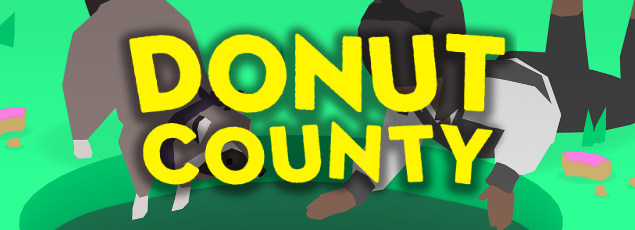
Video games don't just provide us with the opportunity to interact with fictional worlds; they also ingrain in us mindsets through which we process those worlds. Often, how we receive a game environment is a product of not just its contents but also the tools we have to interact with it. In the realm of shooters, we perceive most characters as targets because these games place a gun front and centre, sometimes literally. If you want the inverse, look at a game like Viva Piñata, which situates us in a natural wonderland and hands us gardening implements and food. With those tools in our palms, we find ourselves protecting and nurturing plants and animals.
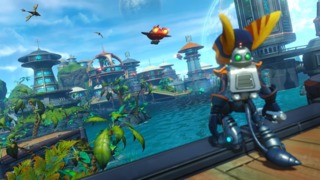
Player tools can also be relatively abstract. In some action games, we can't run off of the edge of a surface, or if we do, it will trigger a loss state, but in a platformer like Prince of Persia or Ratchet and Clank, one of our primary tools is the ability to leap across chasms. In games without jump mechanics, we often view pits as barriers, but in platformers, we see them as a means of transit to somewhere else in the environment, precisely because of the tools under our belt. Whether our tools are physical or abstract, it's also possible for the elements they operate on to be abstract themselves. Donkey Konga features the classic rhythm game task of interacting with geometric patterns that scroll across the screen. These shapes do not depict real physical objects, but they do remind us of a system of representation we're familiar with: because they exist on a musical stave, we perceive them as notation, and due to the drum peripheral in front of us, we go into the play with a mindset of working out what to hit when.
You'll also notice from the above examples that the tools we use and the mindsets we adopt say something about the protagonist we occupy and facilitate roleplay. In giving us a gun and inviting us to view the environment as a firing range, a game can have us roleplay a soldier. If we're running around with a seed bag and a watering can then it only makes sense that the NPCs in Viva Piñata treat us like a gardener. And so on, down the list. It's not surprising that games are so coloured by the tools they give us to work with; the attribute that distinguishes them from other media is their interactivity, and the tools are how we interact. Interactive capabilities aren't the only element that alters our perception of game worlds: dialogue, art, sound, UI, objectives, and rewards are indispensable contributors. However, developers often design those pieces to match our tools or decide our tools based on how they've laid out these other portions of the design. For these reasons, it's a constructive exercise to take note of what tools games give us, how those tools change our viewpoints and behaviour, and how those perspectives and actions match or don't match the character we're meant to be controlling or the messaging and aesthetics of the experience.
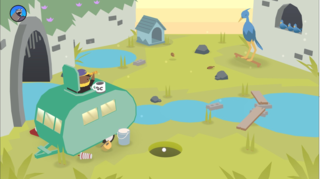
Of course, I used very cursory descriptions of tools and how they fit into larger designs in each of those examples, so let's crack open a game and get a more thorough look at how they can frame and influence an experience. Donut County is a 2018 physics game from indie developer Ben Esposito. Set in a homely rural community, Donut County has players take on the role of B.K., a pudgy and self-centred racoon who runs a local doughnut shop. He spends most of his day messing with an app on his tablet computer which he can use to make a mysterious hole to appear in a distant location. This hole is both our avatar and our tool in the game, and as B.K., we can use it to swallow up nearby objects. As the hole eats items, it expands, allowing us to wrap its teeth around ever-larger entities. Once we sweep an area clean, the negative space closes up, B.K. receives some XP, and we move onto the next stage. Our furry scavenger is inseparable from this app because it promises him the grand prize of a quadcopter if only he can reach level 10.
If we can learn more about games and their protagonists by looking at the properties of their tools, we should ask "What are the properties of the hole?". Most obviously, it's highly destructive. Destructive tools are standard in video games; anything that could be used to eliminate an enemy or a piece of geometry is a destructive tool, whether it's an attack, a weapon, or another practical implement like a pickaxe. In empowerment fantasy games, the thrill of wielding a destructive tool is often in entering a space abundant with objects or characters and using that tool to remove them from that space; Donut County takes that idea to its logical extreme. You're not just mowing down a wave of demons or busting through a wall to follow the mission's breadcrumb trail; levels are only complete when you've cleared all objects on the screen. Everything must go.

Although, we should note that the narrative and symbolism around the hole make it a little less scary than that sounds. While an AK47 or a stick of dynamite are violent and often gory means to destroy whatever stands in your path, the hole is a comical counterpoint to them. In western animation, it's typically associated with mischief, especially in the old Warner Bros. shorts. When the hole consumes characters in this game, their reactions are not fear or pain like the victims of gunfire in a violent action title; instead, they fall through the ground with a hilarious deadpan. And whatever function that gap in the earth might have in the mechanics or code, we know holes don't destroy people or objects, they just move or contain them, and the game acknowledges this.
In the dialogue scenes between levels, we catch up with B.K. and the townsfolk in a subterranean cave where the hole has dumped them and their possessions. Similarly, levels end with a chance to review the "Trashpedia", a codex of all the items that we've swallowed with the pit so far. The Trashpedia gives the impression that rather than having destroyed items, we've collected them. Effectively, the hole is one of the portals from Portal, but instead of us using it to teleport ourselves through the environment, we use it to teleport props and characters out of the environment. It isn't a black hole or a bottomless pit which is what we might assume if we never saw what was on the other side; it's a doorway to the underground.
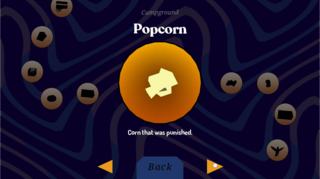
This tool and the Trashpedia were inspired by, among other media, Keita Takahashi's Katamari Damacy games which also gave us the joy of ripping apart a level like a disgruntled house pet using non-violent means. In Katamari Damacy, you affix items to an immense sticky sphere that grows as you attach more objects onto it, allowing it to pick up larger pieces of junk, expanding it further, and round the cycle goes. Many games increase the power of our tools based on this feedback loop: The better you use the tool, or the longer you use it for, the better a tool you get, which gives you a sharper edge in earning an even better tool. In racing games, driving skillfully wins competitions which earns you cars with better top speed, handling, and acceleration; in an RPG, winning combat encounters can earn you gear with higher stats which increases your prowess during future battles. The pacing of many games is influenced by the length of the time between when we start using the tool in the manner that earns rewards and when we receive those rewards.
MMOs create steady pacing by leaving relatively long gaps between new loot and levels; an unsparing loot racing game like The Crew moves a bit faster, giving you new kit after every race, even if it tends to increment your stats only slightly each time; Katamari and Donut County move at a breakneck speed. As soon as you collect a new item, your tool becomes more powerful, and environments are lousy with items: you're capturing them every few seconds. It creates a feeling of frantic, runaway success, matching the games' absurd and light-hearted tones. It's possible to have such a sudden increase in our tool's power because almost none of the upgrades to it carry between levels; no matter the size of our hole or our katamari when we end one stage, it will start off small again at the beginning of the next.

It wouldn't be possible for individual upgrades to be this empowering in a game with persistent rewards because if you're just going to give the player the rocket launcher or the Lamborgini off the bat, then there's not a lot for them to earn in subsequent missions. Resetting the tool between levels solves this problem so that you can experience the equivalent of the rocket launcher in every level, giving you liberating destructive potential. Although, the trade-off for such games is that they cannot have a long-term upward power curve. For Donut County, this isn't the problem it might be for other titles, as it is a brief, two-hour experience, relying on its charm, narrative, immediate feel, and visual feedback, as opposed to permanent stat investments.
It's not that we don't see some development of our capabilities over the course of the game, it's just that it doesn't come in the form of a bigger stick. One way to delight players and switch up your play is to show them their tool doing something they wouldn't have thought possible before and that's what Donut County is going for. The further you can drag a tool away from its original behaviour patterns, the more potential it has to be refreshing in its applications; although if a tool's new behaviours are distinct enough from its initial behaviour, we may frame this scenario as the game giving players an entirely new device.
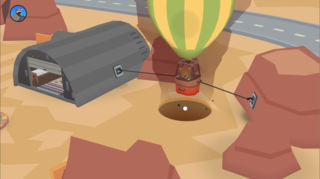
Donut County manages to retrofit some surprising new powers onto our tool. We spend the first several levels of the experience watching objects fall into the hole, so what better way for Esposito to turn the premise on its head than to have objects fly out of the hole? It's delightfully shocking because it's the exact opposite of what we've been trained to expect. Our avatar first ejects objects in the level Potter's Rock when we have it absorb some burning wood, and see smoke rise back out of it. We can then use that smoke to push a hot air balloon skyward. Later on, we can make fire fly out of the hole which we can use to ignite props in the scenery, and in some subsequent levels, we go on to cause popcorn, rabbits, explosives, and hurricanes to burst out of it. Eventually, we receive a catapult that enables us to launch the last few items the pit has consumed back into the air.
Donut County also has us rethink what's possible with the hole through it displaying different behaviour based on what kinds of matter fall into it. From the start, the game drills into us the idea that the hole is effectively bottomless. It's this weird non-euclidean object that, for the purposes of play, has finite dimensions on the surface, but can store infinite mass. However, the game subverts our expectations by showing that if we move this negative space through a body of liquid, the liquid will fill it. The first time we see this, it's in the level Riverbed as we have the hole cut across a puddle, but Esposito develops the concept in the level Cat Soup where we find we can use the empty gap as a pot with which to make food. Curiously, if there is liquid in the hole and we pass it under a drinking bird, the hole will become a bottomless pit again. It's another magical surprise due to its apparent impossibility.
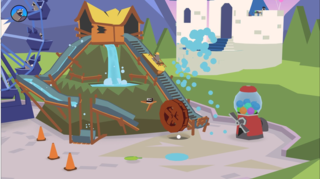
While there's a lesson to be learned here, it's not that designers can make mid-game adjustments to their mechanics without thinking about the repercussions. Sudden changes in play can make it feel inconsistent, and the audience can become frustrated if developers rewrite the rules without an adequate explanation. Spontaneously mutating any mechanical element can also stop it gelling with other mechanical elements if the overall design does not properly accommodate the change. Donut County provides some idea, however, of how designers make introduce these surprises without them being jarring, and it does that by having us discover new properties of its primary tool organically.
Some games introduce modifiers and new abilities by forcing us to run right into them or otherwise imposing them on us, but this can feel heavy-handed and unrealistic. Donut County smoothly transitions us into the use of these mechanics not by putting the hole on a track with the fire or the water partway along it, but by having the objective be to pick up every item in a level. We can't leave the stage without collecting the fire, water, popcorn, soup, etc. but when we do, it's out of voluntarily steering the pit into these objects, so it doesn't feel forced. Although, the catapult is an exception to that rule. Additionally, when we receive a new mechanic, it doesn't take much effort to figure out the puzzle of using it because the items in the game behave like their real-life counterparts: fire burns, catapults launch things, etc. and even once you've discovered these mechanical curiosities, levels mostly still consist of using the hole to gobble down objects. That continuation of the original use of the hole means that it doesn't feel like the game has switched modes; fire, liquid, bombs, wind, and catapults exist comfortably on top of the game's undercoat.
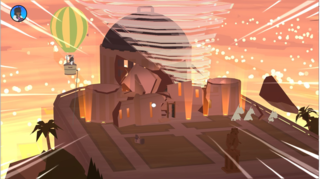
We've spent the majority of this essay looking at how the hole functions within the mechanics, but it's also worth looking at how the writing uses this tool to send a message to the player and lay down the stepping stones of a story. The interstitials between Donut County's levels mostly consist of the villagers of the county explaining how their lives were ruined by B.K. dropping all their possessions into the underground. Eventually, the residents and B.K.'s friend Mira convince him to try and fix the local homes and businesses by paying a visit to the Trash King, whose company distributed B.K.'s app and quadcopter. As we find out once they reach his headquarters, the racoons moved into the region a little while ago, and when they did, they began hoarding goods in the area. Since then, life in Donut County has gone downhill for everyone except the greedy racoons whose leader now lives a life of wealth and luxury. As B.K., we use the hole to wreck the king's castle, but the furry monarch tries to discourage our demolition with a generous financial offer. Our protagonist says "no" and uses a combination of the hole and a quadcopter to wreck the Trash King's abode. Mira and B.K. force the Trash King to build an elevator to launch the residents and their belongings back to terra firma.
On one level, we can see Donut County as being about the collateral damage we do in games and how it would affect real people. We're used to running around action titles throwing bombs any which way or barging into peoples' homes and ransacking them for valuables, even when we're meant to be the hero. Donut County has us wield a tool that is only capable of environmental destruction and collection, and says that, in reality, these types of tools risk destroying peoples' livelihood. Using them makes us not the hero, but the villain, at least, if we use them without a mind for who and what we're targetting.
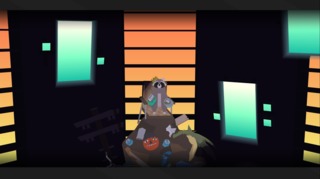
Alternatively, Donut County is about possessions and the transfer of those possessions between people. The racoons, including B.K., are a stand-in for the economic elite. They move into an area and only consume, and soon enough, the people in that territory are left without assets of their own or even disappear from it because their livelihood has dropped out from under them. The racoons have gentrified Donut County. The tool of the hole and the Trashpedia have us emulating that consumptive behaviour, absorbing and collecting goods from the people who need them. The emptiness of this consumption is underlined by the items we sweep up having trivial long-term value to us. They're a one-sentence description in an in-game gallery; the second we understand what we've acquired, we're already gobbling up the next set of trinkets. There's a great metaphor here for how the rich get richer: as we dump more things into the hole, the hole gets bigger, allowing us to put more things into it. B.K. and the Trash King try to excuse their behaviour, with the former saying he was providing people with the products they craved and the latter claiming that he did what he did to help out the racoon population. These are plays on common defences of consumer capitalism, but these arguments come across as disingenuous in this narrative context and weak in the face of the damage done to the county.
A third and related interpretation: The hole is a metaphor for our appetite for material things. It feels sensible to keep squeezing items into it, but not only is it effectively bottomless and not filled by what we feed it; compulsively attempting to fill it only increases its appetite. The goods we acquire don't make us happy, but the act of acquiring them does, and so we continue to consume with consumption as an end in itself, all at other peoples' expense. The game satirises that urge for material satiation by comparing it to being a racoon, rifling through rubbish. Once we start helping the townsfolk, there is no post-stage XP bar, and the promise of a quadcopter vanishes, i.e. There's no material gain to be had. This makes the play a smidge less satisfying, but we sacrifice a little gratification for the knowledge that we're doing the right thing.
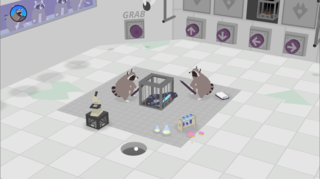
In the final level, as we attack the Trash King's HQ, Donut County comments that if we are capable of taking goods from other people to benefit ourselves, then it's also possible for us to use that acquisitiveness to dismantle the empires of the affluent. Although, the game doesn't systemise much about the process of rebuilding after we've confiscated those stolen assets. Because the basis of Donut County's mechanics is a destructive tool rather than a constructive one, there's this quick turnaround from ripping apart the final boss's lair to everything being back in its rightful place with no transitional scenes of putting the town back together. In the credits scene, instead of driving the hole, we fly a quadcopter around the county, reflecting B.K.'s growth from a hunger devouring the town to a blissful observer. All this talk about consumerism and collateral damage might sound grandiose, but through the game's aesthetics, characters, and play, it can deliver it in a humorous, rather than dramatic fashion. Not a lot of people are going to show up for a dry socioeconomics lesson, but they might turn out to see Katamari with a hole.
In conclusion, the tools that games have us use decide a large part of what it is to play those games and significantly influence who the characters we play are. In Donut County, the cartoon hole gives us the sense of a game and protagonist that are playful but concerned with destruction and collection. Games typically have us use such tools to improve the power of the tools themselves and how quickly we can cycle through that loop helps define pacing. You can also see how, with the right framing, a simple tool can be used for some fairly complex symbolism. In this title, late-game events contextualise the tool's consumption and destruction as symbolic of the hoarding of material assets, while a fast feedback loop between picking up items with the hole and the hole expanding clearly demonstrates how goods become reinvested to acquire more goods or how our appetite for possessions paradoxically grows as we feed it. Throughout, Donut County keeps our attention by changing our expectations for what we can do with that tool both mechanically and narratively, and by shifting the target of our tool, it alters the context and morality of our actions. Thanks for reading.
0 Comments